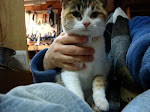As far back as he can remember, Mr. Fuzzy had been fascinated with all thing Native American. He might have misspent his life as an anthropologist where it not for the intervention of one truly horrible professor at the University of Louisville in 1968 who caused him to reconsider said field and spared him from such a fate.


The CLA show just gleams and sparkles with eye-candy consisting of superior Native American art objects. One category that is always engaging is quill-work and moose hair embroidery. Before the white man traded glass beads to the original inhabitants of this land, the North Eastern tribes (and some others) decorated their moccasins, bags, garters, straps, etc., with the dyed quills from porcupines and dyed moose hair. Although a number of artisans in the CLA practice these forms, several would be considered pre-eminent. Lally House of Kentucky has practiced this form for several decades and has managed the nearly impossible - to develop a style of her own but remain true to the historical examples. From Utah, Shawn and Amanda Webster are masters of both the quill and hair, on many forms. To really appreciate these images, click on them to obtain a larger version... Amanda and Shawn are shown above; Lally's work is shown below.

It is fairly rare that these artists are Native Americans themselves; one exception is Michael Galban, although he lives and works in New York state, his place of origin is Nevada. Michael works at a major historical
site, a Seneca village in the 18th century. Michael works in many media, one of those renaissance artists, from pipestone to brain tanned leather. Here are two pictures of his display, with all sorts of items: cradle boards, quilled leather bags, twined bags, shell gorgets, calumets, garters, etc., all of fine quality.


A long-time artist in this field

is
Jan Zender and his partner in life and art, Rochelle Dale. More than anyone I know, they walk their talk. They live in a truly remote area of northern Michigan without running water or electricity (although they now have a solar-charges cell phone). They have, for decades, lived the lifestyle of those whose arts they re-create. They make trade silver, moose hair objects, especially wonderful burl bowls, etc. The photograph at left shows Jan and his booth at the show. Jan and his longtime friend. master cordwainer,
Steven Lalioff, sometimes share artistic efforts and work in tandem on objects.
All of the artists shown above create their art in almost exactly the same manor as their antecedents centuries ago. They have spent years of time studying originals in museums throughout America and Europe; this is a constant duty as new artifacts and papers describing them become available. The objects are all within the period of white contact. One artist, Lisa Crews (now of Arkansas but soon to reside in Kentucky) creates masterful reproductions of archaeologically recovered ceramic wares that were the mainstay of the middle and Caddoan Mississippian culture of 900 to 1500 A.D. She has very cleverly adapted some modern methods to producing pieces which are visually indistinguishable from their antecedents. Her prices are very realistic and the Fuzzies happily carried home two bowls, one a turkey effigy and the other a beaver (with an integral rattle). We'll use them with appreciation and zeal!



























